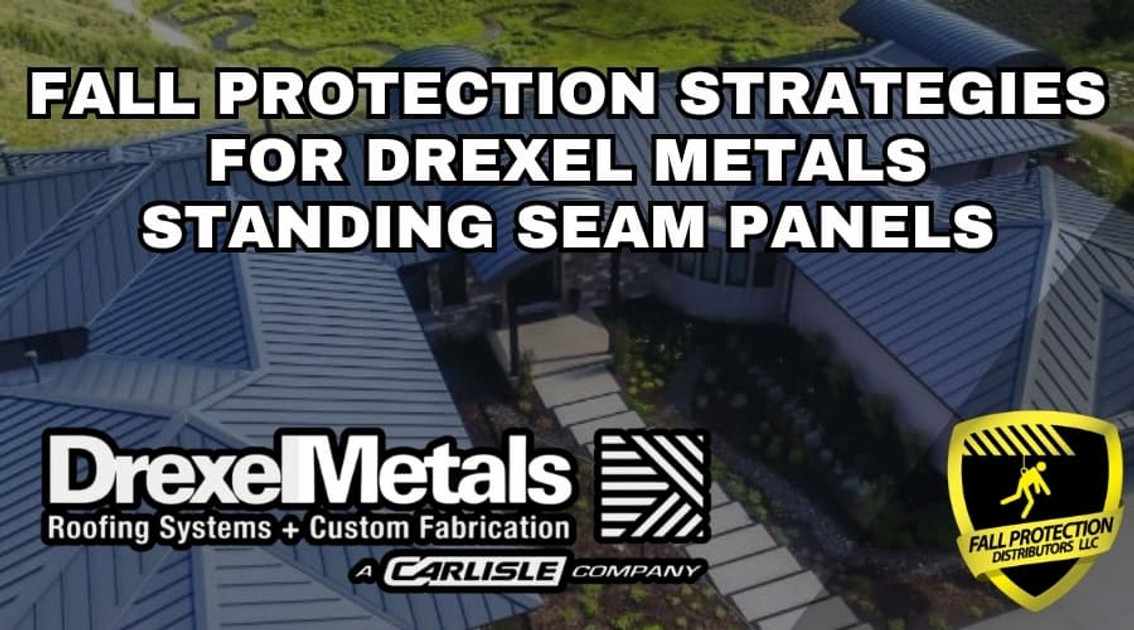Fall Protection Anchors For Drexel Metals Standing Seam Roofs
Posted by Howie Scarboro - CEO Fall Protection Distributors, LLC on Nov 19th 2025
See the Roof Anchor Compatibility Chart for Drexel Metals Standing Seam Panels.

Who Is Drexel Metals?
Drexel Metals built its reputation by pairing American manufacturing with dependable standing seam roofing systems that perform in the real world.
Drexel Metals started in 1985 with a simple mission to provide consistent, high-quality painted metal roofing panels. The company shifted into a new gear in 2009 when it became Drexel Metals Inc. That growth continued in 2011, following the acquisition of Met-Fab Manufacturing. This move expanded its custom fabrication capabilities and deepened its footprint in the architectural metal market.
Today, Drexel operates multiple sales, fabrication, and distribution locations across the country. Contractors, builders, and architects rely on Drexel for engineered metal roofing systems, portable roll-forming equipment, custom trim fabrication, and a long list of accessories that keep projects moving.
Drexel Metals manufactures an extensive lineup of standing seam profiles in pre-painted Galvalume, pre-painted aluminum, Drexlume, and copper. The company keeps production in the United States, which matters when consistency and quality are top priorities. Between the color options, coating systems, gauges, and panel widths, Drexel gives builders the flexibility to match performance with design in a way that feels almost custom.
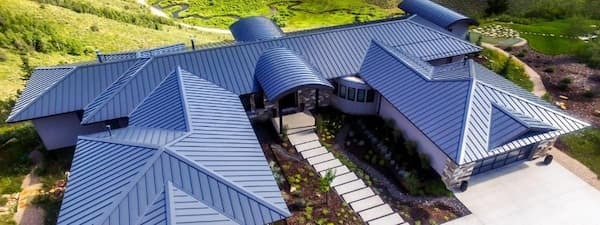
Non-Penetrating Fall Protection Solutions Are Critical For Drexel Metals Standing Seam Systems
Workers stay safer on Drexel Metals panels when they use non-penetrating anchors that protect the seam profile and maintain the roof warranty.
Drexel standing seam systems offer the strength, weather resistance, and architectural detail that metal roof installers seek. Still, they require safety equipment that grips the seams without creating holes or weakening the weather-tight seal. Any seam penetrations can cause panel distortion, leaks, and warranty issues, which is why non-penetrating anchors are required for Drexel Metals standing seam panels.
This article provides installers, safety managers, and building owners with a clear view of the fall protection equipment that fits Drexel Metals' standing seam profiles. It also explains why compatible anchors, horizontal lifeline systems, and steep-assist devices create a safer workflow from the first ladder step to the final piece of trim.
You will see a breakdown of Drexel's main standing seam profiles and the most compatible fall protection solutions for each. When the appropriate anchors match the panel, workers stay properly tied off, and OSHA compliance becomes easier.
200S Mechanical Panel

The 200S 24 Ga. delivers structural strength, design flexibility, and a seam shape that calls for precise fall protection planning.
The 200S 24 Ga. is a 2-inch mechanically-seamed structural system that fits a wide range of commercial and industrial roof applications. The panel comes in widths of 12, 14, 16, and 18-inches, giving architects and project managers plenty of flexibility when matching performance goals. See the Roof Anchor Compatibility Chart for Drexel Metals 200S Mechanical 24 Gauge and 22 Gauge Standing Seam Panels.
A concealed fastener system and a floating clip setup help the 200S manage thermal movement. The 200S panel can be specified for straight or curved roofs, opening the door to some creative architectural work.
The 200S installs in either a 90-degree single-lock or a 180-degree double-lock configuration. Material choices include painted Galvalume in 22- and 24-gauge, Drexlume in 22- and 24-gauge, aluminum in .032- and .040-thicknesses, and copper and zinc. Installers can place the system on plywood or insulated metal decking, and the minimum slope requirement stays at 1.5:12.
Fall Protection for 200S Panels
SSRA anchors provide the best non-penetrating tie-off solution for straight, non-curved 200S panels made from heavier steel gauges.
For straight 200S panels formed from 22-gauge or 24-gauge steel, SSRA1 seam anchors offer a secure, non-penetrating setup. These anchors grip the seams firmly without creating holes, keeping the weather-tight seal intact while still providing workers with a strong tie-off point. When crews need a stable work platform, the SSRA2 Adjustable Roof Jack Adapters mount on top of SSRA1 anchors and support a ten-foot walkboard. That simple combination helps workers stay balanced and productive on steeper roofs.
The SSRA3 Anchor Plates mount on top of the SSRA1 anchors and provide mounting locations for temporary horizontal lifeline systems that can protect multiple workers across a wider section of the roof. For larger roofs, the SSRA HLL 100-foot Temporary Horizontal Lifeline Kit brings dependable fall protection coverage for two workers. Permanent installations can deploy the Super Anchor 120-foot Permanent Horizontal Lifeline Kit, giving building owners a long-term tie-off solution for maintenance crews.
Aluminum, copper, and zinc versions of the 200S panel call for a different approach. These substrates do not support seam-mounted anchors. The Ridge Pro Steep Assist Anchor covers those situations by hooking over the ridge and creating a reliable non-penetrating tie-off point on slopes between 6:12 and 12:12.
Any curved version of the 200S 24 Ga. requires its own safety review. Curved roofs behave differently under load, and a trained safety professional should evaluate the site and choose the safest fall protection method. Only non-curved panels are compatible with SSRA equipment or Ridge Pro anchors.
150SS Mechanical Panel
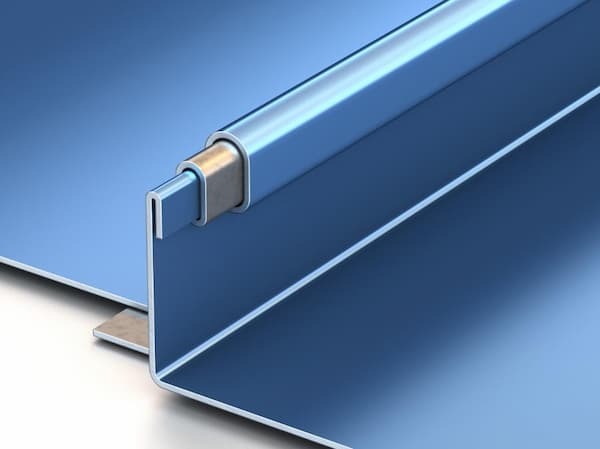
The 150SS panel blends structural strength with architectural flexibility, giving designers room to experiment while still meeting the project's performance goals.
The 150SS 24 Ga. features a 1.5-inch mechanically-seamed design that works well across a wide range of architectural styles. This panel comes in widths of 12, 16, and 20 inches, which keeps it flexible enough for commercial, residential, and specialty projects. See the Roof Anchor Compatibility Chart for Drexel Metals 150SS Mechanical 24 Gauge and 22 Gauge Standing Seam Panels.
One of the standout features of the 150SS system is its ability to be curved. Some projects call for barrel roofs, conical transitions, or architectural shapes that break away from standard straight runs. The 150SS can support those designs while still acting as a structural panel.
The panel is available in 90-degree single-lock and 180-degree double-lock configurations. Material choices include painted Galvalume in 22- and 24-gauge, Drexlume in 22- and 24-gauge, aluminum in .032- and .040-thicknesses, and copper and zinc. Approved roof substrates include plywood or insulated metal decking with the proper underlayment. The minimum roof pitch is 2:12.
Installers can also choose from multiple rib designs, such as flat panel, clip relief, striations, bead, small V, large V, small pencil, and large pencil. These options make the 150SS a good fit for projects where the roof serves both structural and aesthetic purposes.
Fall Protection For 150SS Panels
SSRA anchors deliver the strongest non-penetrating solution for straight 150SS steel panels in 22-gauge and 24-gauge.
For straight, non-curved 150SS panels formed from 22-gauge or 24-gauge steel, SSRA1 seam anchors provide a dependable non-penetrating tie-off point. These anchors clamp directly to the seam without piercing the panel, protecting the roof warranty while providing installers with a strong anchor point. When walkboards are required, the SSRA2 Adjustable Roof Jack Adapters mount on top of SSRA1 anchors and support a 10-foot plank, providing workers with a stable work surface.
Larger crews can expand their coverage with SSRA3 Anchor Plates. These plates mount to SSRA1 anchors and form the base for temporary horizontal lifelines. For wider roof projects, the SSRA HLL 100-foot Temporary Horizontal Lifeline Kit adds a reliable way to protect multiple workers across the roof. Permanent setups can use the Super Anchor 120-foot Permanent Horizontal Lifeline Kit for long-term tie-off access during future inspections and maintenance.
Aluminum, copper, and zinc versions of the 150SS panel are not suitable for seam-mounted anchors. These softer substrates need a different approach. The Ridge Pro Steep Assist Anchor offers a safe, non-penetrating tie-off point by hooking over the ridge on slopes between 6:12 and 12:12.
Curved 150SS panels require inspection by a trained safety professional and may require specialized fall protection. SSRA equipment and Ridge Pro anchors are recommended only for straight, non-curved panels.
100SS Mechanical Panel
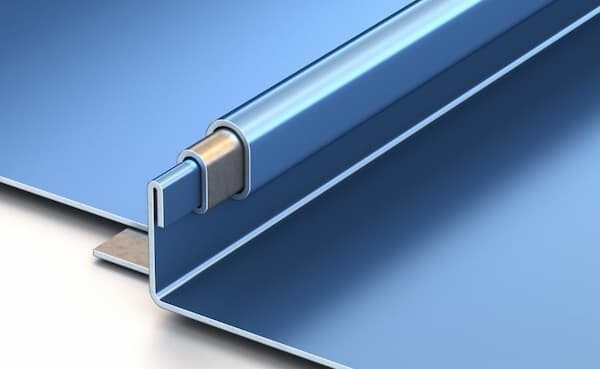
The 100SS panel brings structural performance to smaller roof systems while offering enough flexibility for creative architectural work.
The DMC Cap Seam Snap-On Batten features a 1-inch mechanically-seamed rib, well-suited for light commercial and residential applications. The 100SS panel widths range from 13 inches to 21 inches. The 100SS panel can even be curved when a more complex roof shape is required.See the Roof Anchor Compatibility Chart for Drexel Metals 100SS Mechanical 24 Gauge and 22 Gauge Standing Seam Panels.
The 100SS panel is available in both 90-degree single-lock and 180-degree double-lock configurations. Material options include painted Galvalume in 22- and 24-gauge, Drexlume in 22- and 24-gauge, aluminum in .032- and .040-thicknesses, copper, and zinc. Approved roof substrates include plywood or insulated metal decking with the correct underlayment. The minimum slope requirement is 2:12.
Fall Protection For 100SS Panels
SSRA anchors provide the most secure non-penetrating tie-off option for straight 100SS panels in 22-gauge and 24-gauge steel.
For straight 100SS panels made from 22-gauge or 24-gauge steel, the SSRA1 seam anchor creates a strong, non-penetrating attachment point. This device protects the roof's weather-tight seal, maintains the panel warranty, and provides installers with a dependable tie-off location. When walkboards are required, the SSRA2 Adjustable Roof Jack Adapters mount on top of SSRA1 anchors and support a 10-foot plank, allowing workers to work safely on steep roof pitches.
Larger projects can benefit from the SSRA3 Anchor Plate adapters. These plates mount on top of SSRA1 anchors and serve as anchors for temporary horizontal lifeline systems. When a job needs extended coverage along long panel runs, the SSRA HLL 100-foot Temporary Horizontal Lifeline Kit provides reliable fall protection for multiple workers. Roofs that require permanent HLL protection can use the Super Anchor 120-foot Permanent Horizontal Lifeline Kit, providing building owners with long-term tie-off access for future inspections or maintenance crews.
Aluminum, copper, and zinc versions of the 100SS panel do not support seam-mounted anchors the same way heavy-gauge steel does. In those cases, the Ridge Pro Steep Assist Anchor becomes the recommended choice. It hooks over the ridge to create a stable, non-penetrating tie-off point on slopes between 6:12 and 12:12.
Curved 100SS panels always require additional safety planning. Curved roofs distribute loads differently and should be evaluated by a trained safety professional to determine the most appropriate fall protection solution. SSRA anchors and the Ridge Pro are recommended only for straight, non-curved panels.
175S Snaplock Panel
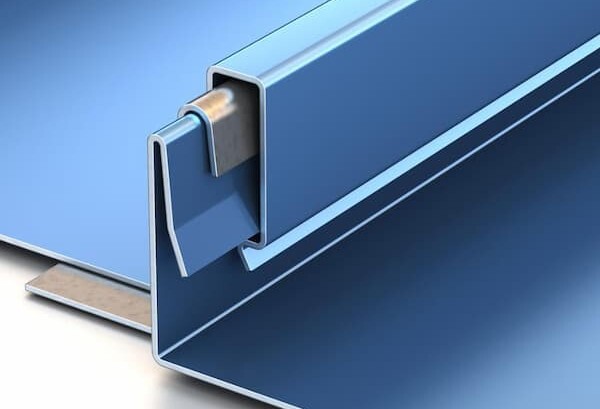
The Snap On Box Batten delivers strong structural performance in a faster snaplock design that avoids the labor of mechanical seaming.
The DMC 175S panel features a 1.75-inch snaplock seam for projects that need strength without the extra steps of field seaming. The continuous interlocking design hides fasteners and clips within the system, allowing the panel to expand and contract freely as temperatures change. See the Roof Anchor Compatibility Chart for Drexel Metals 175SS Mechanical 24 Gauge and 22 Gauge Standing Seam Panels.
The 175S system can be Galvalume in 22- and 24-gauge, Drexlume in 22- and 24-gauge, and aluminum in .032- and .040-thick. Panels can be factory-produced or field-rolled to the exact length required by the project. Rib options include flat panel, clip relief, striations, bead, small V, large V, small pencil, and large pencil for a wide range of visual styles. Widths include 12, 14, 16, and 18 inches, and the minimum roof pitch requirement is 2:12.
Fall Protection For 175S Panels
SSRA anchors provide the most reliable non-penetrating tie-off system for straight 175S steel panels.
For straight 175S panels made from 22-gauge or 24-gauge steel, the SSRA1 seam anchor creates a solid, non-penetrating attachment point. This anchor grips the seam without piercing the panel, keeping the roof weather-tight and compliant with the manufacturer's warranty requirements. When walkboards are needed, the SSRA2 Adjustable Roof Jack Adapters mount on top of SSRA1 anchors and support a ten-foot plank, creating a stable working surface on steeper roofs.
Larger projects can expand coverage by using SSRA3 Anchor Plates. These plates mount to SSRA1 anchors and form the end anchors for temporary horizontal lifeline systems. The SSRA HLL 100-foot Temporary Horizontal Lifeline Kit adds dependable tie-off protection along larger roof systems. The Super Anchor 120-foot Permanent Horizontal Lifeline Kit provides building owners with a long-term fall protection system for maintenance crews. Permanently-installed HLL kits save time and prevent accidents by allowing for repeated tie-off without having to expend time installing anchors.
Aluminum versions of the 175S panel require a different approach. Softer substrates do not support seam-mounted anchors. For these installations, the Ridge Pro Steep Assist Anchor provides a safe, non-penetrating tie-off point by hooking over the ridge on roof pitches between 6:12 and 12:12.
A trained safety professional should review curved 175S panels. Curved roofs behave differently under load and may require a specialized fall protection plan. SSRA anchors and Ridge Pro devices are recommended only for straight panel installations.
450SL Snaplock Panel

The 450SL panel features a snaplock seam that blends strength, low installation costs, and clean architectural lines.
The 450SL has become one of Drexel Metals' most widely used systems because it installs quickly and performs well in a variety of environments. This profile uses a 1.5-inch snaplock seam along with the DMC 450SL clip. Together, they create a continuous interlocking system that speeds up installation and helps crews keep labor hours under control. See the Roof Anchor Compatibility Chart for Drexel Metals 450SL Mechanical 24 Gauge and 22 Gauge Standing Seam Panels.
The 450SL comes in widths of 12, 16, and 20 inches. Material choices include painted Galvalume in 22- and 24-gauge, Drexlume in 22- and 24-gauge, and aluminum in .032- and .040-thicknesses. Panels can be factory-formed or field-rolled to the exact length needed on-site. A minimum slope of 3:12 keeps the system effective across a wide range of roof shapes.
Fall Protection For 450SL Panels
SSRA anchors offer the most dependable non-penetrating tie-off setup for straight 450SL steel panels.
For 22-gauge and 24-gauge steel versions of the 450SL, SSRA1 seam anchors provide a secure, non-penetrating attachment point. These anchors clamp to the seam without piercing the metal, protecting the roof warranty and providing installers with a strong tie-off location. When crews need walkboards, the SSRA2 Adjustable Roof Jack Adapters mount on top of SSRA1 anchors and support a 10-foot plank. That creates a stable platform for safe and steady work on steep metal roofs.
SSRA3 Anchor Plates also mount on top of SSRA1 anchors. They form the anchor points for temporary horizontal lifeline systems, which are essential on larger roofing projects. When more worker mobility is required, the SSRA HLL 100-foot Temporary Horizontal Lifeline Kit provides reliable fall protection on larger projects. For permanent fall protection, the Super Anchor 120-foot Permanent Horizontal Lifeline Kit supplies a long-term tie-off system for maintenance and inspection crews.
Aluminum versions of the 450SL and other lighter substrates are not compatible with seam-mounted anchors. In these cases, the Ridge Pro Steep Assist Anchor becomes the recommended solution. It hooks over the ridge and creates a safe, non-penetrating tie-off point on roof slopes between 6:12 and 12:12.
Curved applications of the 450SL require additional evaluation. Any radius installation should be reviewed by a trained safety professional because curved surfaces behave differently under load. SSRA anchors and Ridge Pro devices are recommended only for non-curved panels.
450 Snaplock Panel
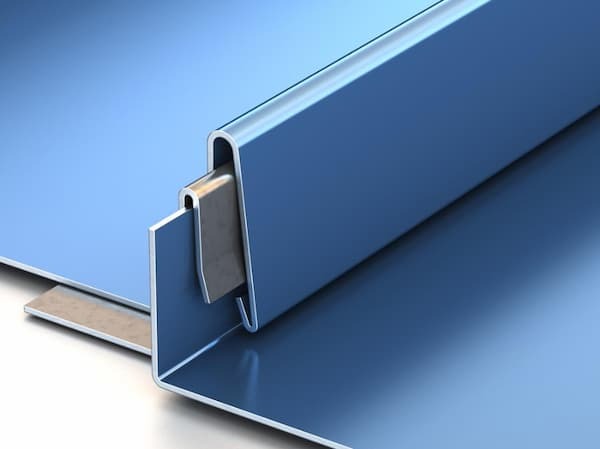
The 450 panel features a clean snaplock seam that installs quickly while still providing the strength needed for structural roof applications.
The DMC 450 system uses a 1.5-inch snap lock profile paired with the DMC 450 Clip to create a continuous interlocking design. Installers appreciate the speed because the system locks together without the added step of mechanical seaming, which keeps installation labor low while helping crews move across the roof efficiently. See the Roof Anchor Compatibility Chart for Drexel Metals 450 Mechanical 24 Gauge and 22 Gauge Standing Seam Panels.
Drexel Metals offers the 450 panel in painted Galvalume in 22- and 24-gauge, in Drexlume in 22- and 24-gauge, and in aluminum in .032- and .040-thicknesses. Width choices include 12, 16, and 20 inches. The system can be factory-produced or field-rolled to the exact length needed on-site. A minimum slope requirement of 3:12 makes the 450 profile suitable for various roof designs.
Fall Protection For 450 Panels
SSRA anchors deliver the strongest non-penetrating tie-off option for straight 450 panels made from 22-gauge and 24-gauge steel.
For straight, non-curved 450 panels formed from 22-gauge or 24-gauge steel, the SSRA1 seam anchor provides a dependable non-penetrating attachment point. This device preserves the panel's weather-tight integrity while providing installers with a secure tie-off location. When walkboards are needed, the SSRA2 Adjustable Roof Jack Adapters mount on top of SSRA1 anchors and support a 10-foot plank, creating a stable working surface for steep roof sections.
SSRA3 Anchor Plates also mount on top of SSRA1 anchors. These plates serve as the anchor points for temporary horizontal lifeline systems. When large roofs need maximum worker mobility, the SSRA HLL 100-foot Temporary Horizontal Lifeline Kit offers reliable fall protection across large projects. For permanent fall protection tie-off, the Super Anchor 120-foot Permanent Horizontal Lifeline Kit provides a long-term solution for maintenance crews and inspectors.
Aluminum and other lighter-gauge materials require a different anchoring approach. Workers should avoid using seam-mounted anchors on these substrates. The Ridge Pro Steep Assist Anchor becomes the preferred option because it hooks over the ridge and creates a safe, non-penetrating tie-off point on roof pitches between 6:12 and 12:12.
Curved applications of the 450 system require an additional safety review. Curved roofs behave differently under load and should be evaluated by a trained safety professional before choosing the appropriate fall protection system. SSRA anchors and Ridge Pro devices are recommended only for straight panel installations.
550S Snaplock Panel
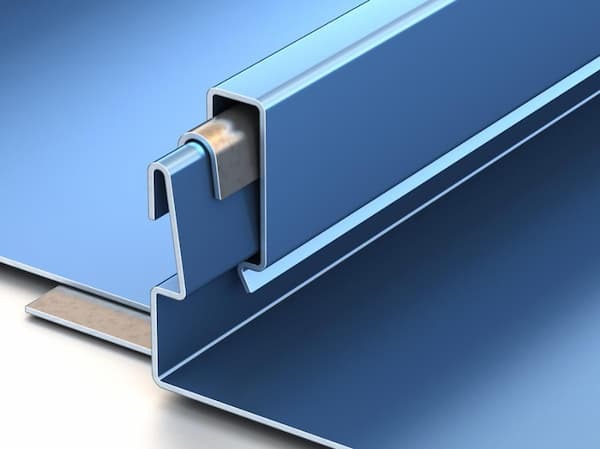
The 550S panel features a strong snaplock system with a clean seam profile, installing quickly and holding up under demanding conditions.
The 550S profile gives builders a premium snaplock system that balances speed, strength, and weather resistance. Crews also appreciate how the interlocking design streamlines installation, as the panels lock together without the added step of mechanical seaming. See the Roof Anchor Compatibility Chart for Drexel Metals 550S Mechanical 24 Gauge and 22 Gauge Standing Seam Panels.
Drexel Metals offers the 550S in painted Galvalume in 22- and 24-gauge, Drexlume in 22- and 24-gauge, and aluminum in .032- and .040-thicknesses. Rib choices include flat panel, clip relief, striations, bead, small V, large V, small pencil, and large pencil. With a 1.5-inch seam height, the panel creates a clean architectural look that works well on residential and commercial projects.
Width options range from 12 inches to 19 inches. The 550S meets strict industry standards for wind uplift, hail impact, fire performance, and environmental durability. Drexel recommends installing the system over steel purlins or plywood decking with the proper underlayment, such as MetShield. A minimum slope of 3:12 makes this panel a good fit for many mid-slope roof applications.
Fall Protection For 550S Panels
SSRA anchors give workers the most reliable non-penetrating tie-off option for straight 550S panels made from 22-gauge and 24-gauge steel.
Straight, non-curved 550S panels formed from 22-gauge and 24-gauge steel work well with SSRA1 seam anchors. These anchors clamp to the seam securely and create a strong, non-penetrating tie-off point that protects the roof from damage. When walkboards are needed, the SSRA2 Adjustable Roof Jack Adapters mount on top of SSRA1 anchors and support a 10-foot plank, providing workers with a safe, steady place to stand while working on steep roofs.
The SSRA3 Anchor Plates also mount on top of the SSRA1 anchors. They serve as the base for temporary horizontal lifeline systems, which are essential when multiple workers need protection across larger roofs. The SSRA HLL 100-foot Temporary Horizontal Lifeline Kit adds dependable coverage for larger jobs. Permanent maintenance access can be handled with the Super Anchor 120-foot Permanent Horizontal Lifeline Kit, giving building owners a long-term fall protection solution.
Aluminum and other lighter-gauge materials call for a different approach because they do not support seam-mounted anchors. The Ridge Pro Steep Assist Anchor fits these installations by hooking over the ridge and providing a safe, non-penetrating tie-off point on slopes between 6:12 and 12:12.
Curved versions of the 550S panel require additional evaluation. A trained safety professional should inspect any radius installation, as curved roofs handle loads differently and may require a specialized fall protection plan. SSRA anchors and Ridge Pro devices are recommended only for straight, non-curved panel installations.
150NS Nailstrip Panel
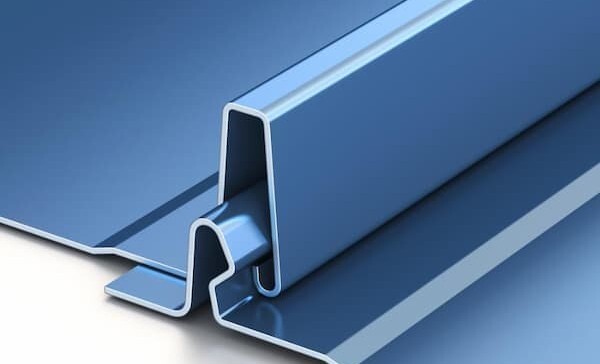
The 150NS panel delivers a clean architectural look with a self-locking seam, eliminating the need for clips or mechanical seaming.
The 150NS profile combines appearance, durability, and strength for residential and commercial projects alike. This panel uses a concealed 1.5-inch self-locking SnapLock seam and nail flange, eliminating the need for separate metal roof clips. That detail speeds up installation and helps the panel form a strong, weather-tight seal that withstands changing conditions. See the Roof Anchor Compatibility Chart for Drexel Metals 150NS Standing Seam Panels.
Material options include painted Galvalume in 24-gauge, Drexlume in 24-gauge, and aluminum in .032- and .040-thicknesses. Rib styles include flat panel, clip relief, striations, bead, small V, large V, small pencil, and large pencil. These choices give designers a simple way to match the panel with the building's visual style.
Panel widths range from 15 inches to 19 inches. This range helps installers tailor the system to the roof layout and overall design goals. The combination of sleek detailing, structural reliability, and strong weather performance makes the 150NS panel a practical option for projects that call for long-term durability and a polished architectural finish.
Fall Protection For 150NS Panels
The Ridge Pro Steep Assist Anchor is the safest non-penetrating option for the tapered nailstrip seams found on the 150NS panel.
The tapered seam shape on the 150NS profile is not compatible with seam-mounted anchors. The shape does not allow a secure clamp location, and using any device that squeezes or compresses the seam risks damaging the panel or loosening the locking mechanism. As a result, the Ridge Pro Steep Assist Anchor is the recommended fall protection solution for this profile.
The Ridge Pro hooks over the ridge and provides a stable, non-penetrating tie-off point on slopes between 6:12 and 12:12. It keeps workers tied off from the moment they leave the ladder until they return, which is especially important on nailstrip systems that cannot support seam-mounted anchors.
Any curved version of the 150NS panel requires its own safety review. A trained safety professional should evaluate curved roofs to determine the safest fall protection method. SSRA anchors and the Ridge Pro system are recommended only for straight panels where the ridge hook can seat properly.
100NS Nailstrip Panel

The 100NS panel offers a clean architectural look with a 1-inch snaplock seam, eliminating the need for clips or mechanical seaming.
The DMC 100NS profile works well on residential and commercial roofs. This panel uses a concealed-fastening flange and a 1-inch snaplock system, eliminating the need for separate metal roof clips. That detail speeds up installation and creates a strong weather-tight seal that handles demanding environments. See the Roof Anchor Compatibility Chart for Drexel Metals 100NS Standing Seam Panels.
Material options include painted Galvalume in 24-gauge, Drexlume in 24-gauge, and aluminum in .032 thickness. Panels can be factory-formed or field-rolled to exact lengths, allowing installers to match the roof layout precisely. Design enhancements such as striations, beads, and pencil ribs offer greater flexibility for projects that require specific visual details.
The 100NS panel works well on low-slope roofs with a minimum pitch of 3:12. Width options include 12, 16, and 20 inches, so contractors can choose the panel size that best fits the project. With its clean lines, simple installation, and long-lasting performance, the 100NS panel remains an economical option for homeowners and builders who want durability and a strong architectural finish.
Fall Protection For 100NS Panels
The Ridge Pro Steep Assist Anchor is the safest non-penetrating solution for the tapered nailstrip seams found on the 100NS profile.
The tapered seam shape on the 100NS panel is not compatible with seam-mounted anchors. The seam shape prevents an SSRA clamp from seating securely. Because of this, the Ridge Pro Steep Assist Anchor becomes the recommended fall protection option for this panel.
The Ridge Pro hooks over the ridge and provides a stable, non-penetrating tie-off point on slopes between 6:12 and 12:12. It keeps workers safely connected from the moment they leave the ladder through the entire roof access process. Drexel Metals offers the 450 panel in painted Galvalume in 22-gauge and 24-gauge, Drexlume in 22-gauge and 24-gauge, and aluminum in .032 and .040 thicknesses.
Any curved version of the 100NS panel requires an additional safety review. Curved roofs behave differently under load and must be evaluated by a trained safety professional to determine the safest fall protection method. The Ridge Pro and all SSRA equipment are recommended only for straight panel installations where the anchor can seat properly.
Cap Seam Snap-On Batten Panel
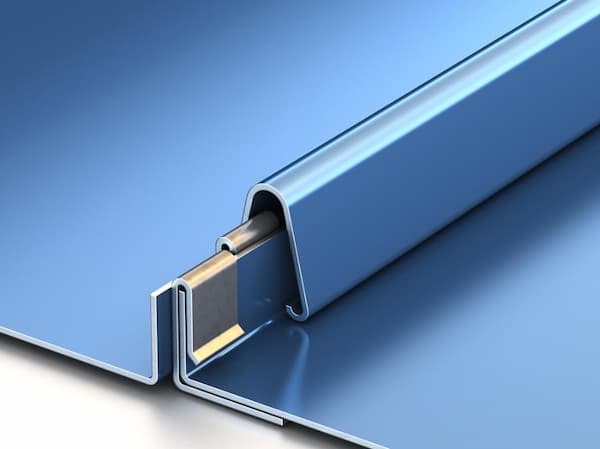
The Cap Seam system blends classic batten styling with modern versatility, giving designers freedom to work with straight or curved roof shapes.
The Cap Seam Snap-On Batten system offers a clean 1-inch batten cap with a flat pan, ideal for detailed architectural work. One of the standout features is its ability to curve to a tight 3-foot radius, which makes this panel a strong choice for barrel roofs, sweeping architectural lines, and other curved applications. Width options include 12, 16, and 20 inches. Material choices include 22-gauge steel, 24-gauge steel, and aluminum. See the Roof Anchor Compatibility Chart for Drexel Metals Cap Seam Snap-On Batten Standing Seam Panels.
The system installs quickly because the snap-on batten design eliminates the need for mechanical seaming. Contractors can order panels in painted Galvalume, Drexlume, aluminum, or copper. Panels may be factory-produced or field-rolled to precise lengths, allowing crews to fit the layout exactly.
Drexel's MetShield underlayment pairs well with the Cap Seam system, adding another layer of weather protection beneath the panels. When the project calls for curved detailing or custom architectural lines, the Cap Seam system provides lasting durability with a clean, streamlined appearance.
Fall Protection For Cap Seam Panels
The Ridge Pro Steep Assist Anchor gives workers the safest non-penetrating tie-off solution for straight Cap Seam panels.
Straight versions of the Cap Seam Snap-On Batten panel are not compatible with seam-mounted anchors. The batten cap covers the seam entirely, which prevents any clamp from securing safely to the panel. Because of that, the Ridge Pro Steep Assist Anchor becomes the recommended fall protection solution for this system.
The Ridge Pro hooks over the ridge and creates a stable, non-penetrating tie-off point on slopes between 6:12 and 12:12. It works across all available Cap Seam materials, including painted Galvalume, Drexlume, aluminum, and copper. The Ridge Pro keeps workers tied off from the ladder to the ridge and back again, which is especially important on batten panels where seam-clamping is not an option.
Curved versions of the Cap Seam system require a separate safety evaluation. Curved panels behave differently under load, and a trained safety professional should inspect the roof before determining the most effective fall protection method. SSRA equipment and Ridge Pro devices are recommended only for straight, non-curved Cap Seam roofs.
Snap-On Batten – Box Batten

Drexel Metal's Box Batten panel creates bold architectural lines with a snap-on cap system that installs quickly and performs well on steep or decorative roof sections.
The DMC Snap-On Batten system brings a strong visual presence to roofs that need bold shadow lines and defined architectural character. The 1.5-inch batten cap creates a deep, dimensional profile that looks right at home on mansards, fascias, and other high-visibility roof sections. This panel requires a minimum roof pitch of 3:12 for proper drainage. See the Roof Anchor Compatibility Chart for Drexel Metals Snap-On Batten – Box Batten Standing Seam Panels.
Material choices include painted Galvalume in 22, 24, and 26-gauge; Drexlume in the same gauge range; and aluminum in .032- and .040-thick. These selections give designers enough flexibility to match the project's appearance and structural needs. The installation process remains straightforward because the snap-on cap eliminates the need for mechanical seaming.
Panel styles include flat panel, clip relief, striations, bead, small V, large V, small pencil, and large pencil. Widths include 12, 16, and 18 inches.
Fall Protection For Snap-On Batten Panels
The Ridge Pro Steep Assist Anchor provides the safest non-penetrating tie-off solution for box batten systems where clamps cannot grip the seam.
The box batten design fully covers the seams, which prevents any seam-mounted anchor from clamping securely. As a result, the Ridge Pro Steep Assist Anchor is the recommended fall protection option for the Snap-On Batten profile. The Ridge Pro hooks over the ridge and creates a stable, non-penetrating tie-off point on slopes between 6:12 and 12:12.
This anchor works across all Snap-On Batten materials, including painted Galvalume, Drexlume, and aluminum. It keeps workers tied off from the moment they step off the ladder until they climb back down, and that matters on batten systems where workers cannot use seam anchors.
Curved applications of the Snap-On Batten panel require additional safety planning. An experienced safety professional should inspect curved roofs, as curved roofs often require specialized fall protection equipment. SSRA anchors and Ridge Pro devices are recommended only for non-curved, straight panel installations where the anchors can seat securely.
Standing Seam Metal Roof Anchor Panel Compatibility Chart For 24 Ga. Drexel Metals
| 200S 24 Ga. | 150SS 24 Ga. | 100SS 24 Ga. | 175S 24 Ga. | 450SL 24 Ga. | 450 24 Ga. | 550S 24 Ga. | |
|---|---|---|---|---|---|---|---|
SSRA 1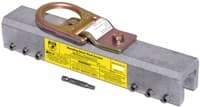 |
NO | NO | NO | NO | NO | NO | NO |
SSRA1 Nylon Tip |
YES | YES | YES | YES | YES | YES | YES |
SSRA2 Roof Jack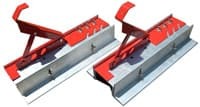 |
YES | YES | YES | YES | YES | YES | YES |
SSRA3 Anchor Plate |
YES | YES | YES | YES | YES | YES | YES |
The Ridge Pro |
YES | YES | YES | YES | YES | YES | YES |
Standing Seam Metal Roof Anchor Panel Compatibility Chart For 22 Ga. Drexel Metals
| 200S 22 Ga. | 150SS 22 Ga. | 100SS 22 Ga. | 175S 22 Ga. | 450SL 22 Ga. | 450 22 Ga. | 550S 22 Ga. | |
|---|---|---|---|---|---|---|---|
SSRA 1 |
YES | YES | YES | YES | YES | YES | YES |
SSRA1 Nylon Tip |
YES | YES | YES | YES | YES | YES | YES |
SSRA2 Roof Jack |
YES | YES | YES | YES | YES | YES | YES |
SSRA3 Anchor Plate |
YES | YES | YES | YES | YES | YES | YES |
The Ridge Pro |
YES | YES | YES | YES | YES | YES | YES |
Standing Seam Metal Roof Anchor Panel Compatibility Chart For Drexel Metals
| 150NS Nailstrip Panel | 100NS Nailstrip Panel | Cap Seam Snap-On Batten | Snap On Box Batten | |
|---|---|---|---|---|
SSRA 1 |
NO | NO | NO | NO |
SSRA1 Nylon Tip |
NO | NO | NO | NO |
SSRA2 Roof Jack |
NO | NO | NO | NO |
SSRA3 Anchor Plate |
NO | NO | NO | NO |
The Ridge Pro |
YES | YES | YES | YES |
Contact Us for Expert Standing Seam Fall Protection Advice
For expert guidance on standing seam roof anchors, lifeline kits, and fall protection systems that protect both your crew and your panels, contact us today at 863-703-4522 or visit www.StandingSeamRoofAnchor.com. Our safety specialists can help you match the right non-penetrating anchor to your specific roof profile and slope. Let's make your next metal roofing project safe, compliant, and built to last. For continued learning, download OSHA's 48-page Fall Protection Manual and our free Anchor Inspection Form once you've selected the ideal anchors for your roof system. Together, we'll help you stay ahead of OSHA standards while preserving your roof's weather-tight seal.
Safety Tips For Standing Seam Roofs
Equip Workers with High-Quality Safety Gear
High-quality gear is the first line of defense on any Drexel Metals roof system. Crews work more confidently when their harness fits correctly, their Malta Dynamics SRL runs smoothly, and every connector has passed a hands-on inspection before the shift begins. With OSHA giving greater attention to fit, adjustment, and inspection cycles in 2025, safety managers should ensure harnesses match each worker's body type. A properly fitted harness, paired with an SSRA1 tie-off or Ridge Pro ridge anchor, becomes the foundation for safe access on every Drexel job.
Develop OSHA-Compliant Safety Plans
A detailed safety plan eliminates the guesswork that often leads to serious incidents. Mapping out tie-off locations, defining when to switch from restraint to arrest, and establishing clear rescue procedures gives every worker a task to perform when accidents happen.
Set Up Protective Guardrail Barriers for Work Zones
Guardrails remain one of the simplest and most effective safeguards on large Drexel Metals structures. When placed around roof edges, openings, and staging areas, they act as visual and physical boundaries that help crews maintain situational awareness. On larger projects, these boundaries help crews maintain safe movement patterns while focusing on the work at hand.
Ensure Proper Footwear for Stability
Slip-resistant roofing boots with solid ankle support help keep workers balanced. Proper footwear, combined with a secure tie-off to SSRA1 seam anchors or a Ridge Pro ridge point, gives workers a stable three-part safety system: traction, balance, and fall protection.
Use Specialized Anchor Systems for Standing Seam Roofs
Standing seam systems require non-penetrating fall protection anchors. The SSRA1 Standing Seam Roof Anchor grips the seam with stainless steel set screws, without penetrating the seams. That keeps the roof weather-tight and protects the manufacturer's warranty. Many older clamp systems require heavy torque (ft/lbs) or require guessing the location of hidden clips. Avoid both. The precision seam attachment of the SSRA1 anchor with low-torque(in/lbs) set screws preserves panel integrity and ensures a reliable tie-off point. No other fall protection device uses 12 set screws to evenly distribute the load across a 12-inch section of the seam.
Promote a Culture of Safety
A short morning huddle about weather, panel layout, trip hazards, and tie-off strategy sets the tone for the entire day. Crews who talk about close calls or missteps help others avoid repeat scenarios. When installing SSRA1 anchors or moving along steeper roof sections, clear communication can prevent a worker from getting too close to a fall hazard. A strong safety culture turns safe behavior into a habit, not an obligation.
Encourage the Use of Trauma Straps
Stopping the fall is only the first step. Trauma straps give a suspended worker a simple way to shift weight, relieve leg pressure, and maintain circulation while waiting for rescue. Safety managers should treat trauma straps as essential equipment, not an optional add-on, and include them in the required safety equipment for each worker at risk of falling from height.
Consult Experts for Curved Metal Panels
Drexel Metals manufactures several curved panel profiles, which introduce unique challenges that standard fall protection may not always address. A fall protection specialist can evaluate the roof to determine the safest approach. Expert planning protects both workers and the roof system from damage caused by the wrong anchor choice.
Install Permanent Roof Anchor Systems
Building owners and facility managers working with Drexel Metals roofs often need ongoing access for HVAC service, snow retention checks, or inspections. A permanent option, such as the Super Anchor 120-foot Permanent Horizontal Lifeline Kit, gives maintenance crews a ready-made tie-off system without adding holes to the panel surface. Permanent systems reduce setup time and turn routine access into a simple tie-off process that meets OSHA and ANSI requirements year-round.
Prioritize Ladder Safety Training
Many fall incidents start at the ladder, long before a worker reaches the roof. Ladder training should focus on inspecting the rails and rungs, setting a proper angle using the four-to-one rule, and maintaining three points of contact during every climb. Good ladder habits build safe behavior before a worker ever ties off to an SSRA1 anchor or steps onto a Drexel Metals roof. When crews respect the ladder, they reduce risk before the day even begins.
Disclaimer
The views, recommendations, and information presented in this blog are solely those of the author and do not necessarily reflect the opinions or positions of the featured panel manufacturer, its brands, subsidiaries, or parent companies. Customers are strongly encouraged to contact the roof panel manufacturer directly for inquiries regarding fall protection compatibility with their products and to address any potential warranty issues that may arise after installing our products.

